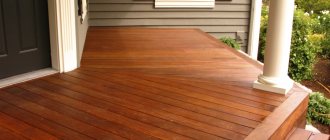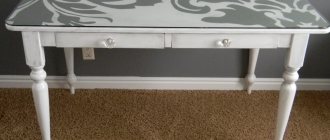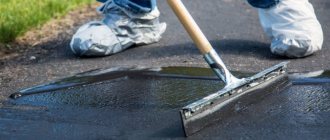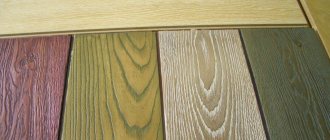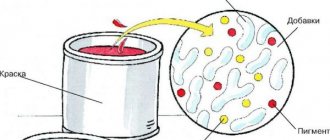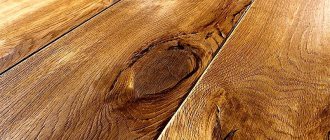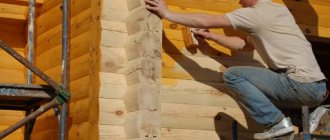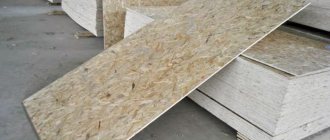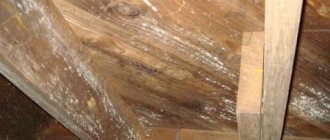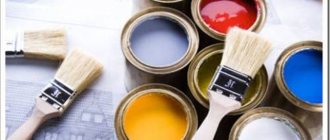What to do before staining
Many homeowners prefer a wooden porch for many reasons: it is easy to make with your own hands, it feels pleasant to the touch and looks beautiful, but most importantly, wood is a living, warm material.
However, it is precisely its naturalness that is also its vulnerable feature, since the tree is susceptible to rotting and does not withstand mechanical stress, insect attacks and fire. Therefore, it needs protection from all these factors, which decorative paint alone cannot provide. But there are many special compounds that can increase the moisture resistance and fire resistance of wood, protect it from pests, the destructive influence of sunlight and other aggressive influences.
Ready-made protective compounds
Wood is heterogeneous in its structure. There are many pores, capillaries, knots and roughness on its surface. Sanding allows you to level the surface so that all protective and decorative coatings are absorbed into it evenly.
Before painting an outdoor wooden porch, it is recommended that you first sand it and then treat it with the following products:
- Moisture-proof impregnation - it is very important to protect the wood from exposure to precipitation and humid air, as they can cause rapid destruction from rot.
Pinotex – excellent protection against moisture
- Antiseptic impregnation - will not allow fungi and mold to develop in the material, will protect it from attacks by wood-boring insects.
Antiseptic "Neomid" for wood
- Fire retardant impregnation - performed with special fire retardant compounds, makes the wood more resistant to fire.
Fire retardant “Ogneza”
These compounds are applied in exactly this sequence, one at a time, with breaks for each layer to absorb and dry.
Advice. You can buy a universal 3 in 1 product, but the effect of each of its components will be weaker than when acting according to the described algorithm.
What can replace special products?
The price of each of the described products is quite high, so instead of them you can use materials that are found in most households:
| Type of product | Properties and Application |
| Consisting of turpentine and natural oils, drying oil penetrates deeply into the wood, giving it water-repellent properties. This material can even be used to process those parts of the porch that come into contact with the ground or go into it. |
| The so-called “working off” also perfectly protects the wood from moisture and rotting. |
| A well-known antiseptic that destroys any bacteria and microorganisms. A solution of potassium permanganate has not only disinfecting, but also decorative properties. After processing, the wood pattern becomes clearer and more contrasting, and changes color. |
| Unlike many other antibacterial agents, it does not create an airtight film on the surface, allowing the wood to breathe. It is useful to treat ends and saw cuts with lime. |
Note! There are no readily available analogues to fire retardant impregnations. They need to be purchased specially.
Tips for choosing
When deciding what is best to paint a wooden porch, you need to consider the following:
- Does moisture get on it during precipitation or melting snow?
- How the sun's rays affect painted surfaces: do they fall directly or not due to shading.
- Wind influence: from which direction it blows more often.
- Passability: how many people will use the porch.
- Seasonal temperature fluctuations.
- Where does the porch go: onto a busy street or onto a garden.
Taking into account all these factors, it is recommended to choose a paint and varnish product.
But it is not necessary to use colored dyes. If the wood is new and the boards have a beautiful texture, then the use of transparent or tinted varnishes will highlight the unique beauty of the wood.
Choosing paint and varnish materials
The most common mistake when painting a porch is the incorrect selection of coating for the wooden surface of the steps. If you simply paint the porch and steps with one of the most accessible and inexpensive varnishes, for example, alkyd or acrylic, then after a few months of use a dark-colored path will form on the landing and stairs. The reason for the defect is very simple:
- Ordinary varnish is quickly wiped off by the soles of shoes, and the wooden surface is exposed;
- Sanded wood wears down to fibers, into which microscopic particles of soil and dust are packed.
For your information! To remove dark marks on a wooden surface, you will have to sand the steps and paint them with a new layer of varnish or paint.
After the third sanding, a depression will appear on the surface of the steps and platform of the wooden porch, which can only be painted and covered with a rubber mat, completely ruining the appearance of the nice porch.
Therefore, the steps and the upper platform must be painted with a wear-resistant material, preferably deck paint or varnish. It is quite difficult to buy it, but it is possible. If you don't like the price, you can use regular polyurethane, acrylic-polyurethane or epoxy varnish for parquet.
Such paints are not afraid of water, and a properly constructed porch quickly gets rid of surface moisture, so there is practically no danger of wooden steps swelling. It is best to paint it with clear or tinted varnish to look like old walnut. In this case, it is easier to choose a cheaper varnish of a similar toner. You can paint the entire porch with epoxy or polyurethane varnish, but there is no particular point in such a solution; painting will be quite expensive.
Characteristics of paint and varnish material
When choosing what to paint a wooden porch on the street, pay attention to the technical characteristics of the paint and varnish material.
There are two types of decorative coating.
- dye;
- varnish
Dye
This pigmented composite composition is based on a resin, an organic solvent, and a film-forming substance.
Oily
This decorative coating has only one advantage - the low price of the product. Its main disadvantages are the fragility of the layer and rapid fading in the sun. But oil paint can be used as a primer. To do this, it is diluted with turpentine, white spirit or another solvent.
Acrylic
Acrylic LMS hold a leading position in the paint and varnish material market. They are moisture-resistant, durable, have a rich color palette, and dry quickly. They can be used to paint a veranda, terrace, staircase, or wooden bench. But this paint also has disadvantages: high price and toxic components.
The best manufacturers in this category are:
- Pinotex Ultra (Estonia) – consumption: 150 ml per 1 sq. m. Service life 5 years.
- BelinkaToplazur (Slovenia) – consumption: 150 ml per 1 sq. m. Service life 5-6 years.
- Teknal2460 (Finland) – consumption: 170 ml per 1 sq. m. Service life 3-4 years.
- Yaroslavl paints (Russia) – consumption: 150 ml per 1 sq. m. Service life 4-5 years.
Water-based
The basic base is acrylic and water. This painting material protects the wood from insects and bacteria. It dries quickly, has no odor, and is easy to apply. There are two thousand shades in its color line. But the dye does not protect the surface well from mechanical damage. Therefore, it is better to use it for painting the walls of a veranda or terrace. It is also good to decorate a wooden bench with water emulsion.
The most popular manufacturers:
- TIKKURILA (Finland) – consumption: 185 ml per 10 sq. m.
- AQUA (Superplast, Russia) – consumption: 135 ml per 1 sq. m.
The use of such paint requires preliminary cleaning, disinfection and priming of the surface.
Requirements for varnishes and paints
Based on the listed factors, the requirements for paint and varnish materials are derived:
- The elasticity of a coating indicates how it will resist the tensile loads exerted by expanding wood.
The more flexible the paint, the longer it will last.
- Hydrophobicity of the material - it should not allow moisture to penetrate into the wood.
- UV resistance. There are no such compositions - all paints, sooner or later, will be damaged. Another thing is that you need to choose a composition that will last as long as possible.
- Covering ability - this parameter determines how well the paint adheres to the base and fills the smallest pores and cracks. The best paints create a dense coating even with one layer.
Interesting to know! For outdoor installations, many tree species differing in density are used. Some of them have high porosity (for example, pine), which is why the paint is absorbed into the structure. To solve the problem, the tree must be properly prepared.
Varnish creates a waterproof film on the surface of the wood
- Resistant to temperature changes. These and other characteristics can be found on the specific product label.
High-quality painting should ensure the durability of the coating for up to 5 years.
Non-varnish coatings for wooden porches
To protect wood structures, it is not necessary to use alkyd or expensive acrylic-polyurethane varnishes. The modern chemical industry produces a fairly large number of specialized coatings. For example, specialized wax-based gels. You can paint it once and forget it for ten years. The only drawback is the rather high labor intensity of coating application. While alkyd varnish can paint a porch in two hours of work, wax mastics and gels require mechanical polishing of the texture. The result is a very beautiful and durable semi-gloss finish. If a wooden porch is built from wood with a beautiful grain texture, there is no point in losing the natural beauty and trying to paint the wood with oil paint; it is better to use gel or impregnation.
Oil impregnations are considered the second most popular material for treating wooden buildings outdoors, the floors of terraces and verandas. The simplest wooden porch structures can be painted with natural drying oil; it is better not to use petroleum-polymer grades. Drying oil dries to a hard coating for at least a week; the material dries touch-free in two days.
If the porch is poorly located, with strong shading, then it is best to choose a proprietary oil impregnation from Tikkurila. If you paint the wood according to all the rules described on the can, protection from constant moisture is guaranteed one hundred percent. In addition, oil impregnations surprisingly clearly reveal the natural beauty of wood fibers.
There is absolutely no point in trying to paint a wooden porch with used machine oil:
- Firstly, the risk of ignition of wooden structures increases sharply;
- Secondly, machine oil, unlike natural drying oils and branded impregnations, does not dry out, which means that all the garbage and dust from the street will constantly stick to the wooden surface;
- Thirdly, even if you paint sanded and etched wood, the surface color is far from the most attractive, dirty brown.
In addition, in autumn and winter, when a large amount of water gets on the steps, the oiled surface becomes quite slippery and dangerous.
Which composition to choose
To choose the most suitable paint or varnish, consider the following factors:
- Color – do you need a covering or transparent composition;
- Climatic conditions – maximum winter and summer temperatures. The paint must withstand them;
- Humidity - both the overall air humidity in the region and the amount of precipitation (rain and snow) falling on the porch are important.
Next, the instructions for the selected composition are studied, and the characteristics described in it are compared with your initial data.
Types of decorative coatings
Varnishes and paints also have a protective effect. Most of them form a durable coating on the wood surface that prevents mechanical damage and abrasion.
But the main function of such compositions is decorative.
Therefore, if you are thinking about how to beautifully paint a wooden porch, pay attention to the composition of the material, its color and texture, which should be combined with the facade of the house and the area adjacent to it
Paints
There are different paints, including covering and glazing (which do not hide the wood texture):
- The first ones will be a good choice for an old porch, as they will hide all the defects underneath. They are chosen when they want to “make friends” of the entrance lobby with the painted facade of the house, or when they think about how to beautifully paint the steps of a wooden porch in different colors.
- The latter are used only for new, previously unpainted structures.
All compositions must be designed for outdoor use, withstand significant temperature fluctuations and high humidity.
Among facade paints intended for coating wood, the following are most often used:
Oil paint is the most popular, long-used material. It protects the wood well from weathering, but does not shine and has a pungent odor. It, however, disappears after drying, so this property cannot be considered a minus. But a huge plus is the wide selection of colors and shades.
In the photo - high-quality oil paint from Finnish
Alkyd enamel differs from oil paint by the presence of alcohol and organic acids in its composition. It creates a more durable protective layer on the surface that prevents mechanical damage to the wood. The composition dries quickly.
On the one hand, this is convenient, because you need to climb up the porch into the house, and the faster it dries, the better. But applying quick-drying compounds is more difficult. In addition, the choice of colors for alkyd enamels is not so rich. But they can be matte, glossy and semi-matte.
The most popular enamel PF-115
By marking the steps in advance, you can walk on the painted stairs
Water-based paints are compositions based on water, after evaporation of which a durable coating is formed on the surface. They often contain antiseptics and can protect wood from fungal bacteria even without prior impregnation.
Their advantages also include ease of application, lack of odor and the ability to create any shade by mixing paint with tinting pigments. But such paint does not protect well from mechanical damage.
Water-based paint
Varnishes and impregnations
If you are deciding how to paint a wooden porch so that it lasts longer, or so that it does not hide the beauty of the natural material, choose clear or tinted varnishes. They can be applied both on paint and instead of it.
The polymer film on the surface will repel moisture and keep the wood dry. But keep in mind that the varnish on the steps wears off quickly, so it is better to cover those elements of the porch that are not subject to active mechanical stress. These are posts, railings, balusters, canopies, etc.
The more expensive and better quality the varnish, the longer the coating will last.
The steps can be varnished over the paint, this will give them additional shine and protect them from fading, and also make the coating more durable and durable. Of course, if you choose a composition for outdoor use that is resistant to frost, UV rays and other weather surprises.
What is the best way to paint a wooden porch on the street if the house is built of wood without additional cladding of the facades? Painted structures against their background will look ridiculous and alien.
In addition to varnishes, you can use various glazing impregnations. They come in transparent and tinted, matte and glossy.
Without hiding the natural grain of the wood, they emphasize it, making dark areas even darker and more contrasting. Moreover, depending on the additives included in the material, they themselves can serve as good protection against moisture, mold and bugs.
Protective and decorative impregnation
More details about tree protection in the video:
Which composition to choose
To choose the most suitable paint or varnish, consider the following factors:
- Color – do you need a covering or transparent composition;
- Climatic conditions – maximum winter and summer temperatures. The paint must withstand them;
- Humidity - both the overall air humidity in the region and the amount of precipitation (rain and snow) falling on the porch are important.
Next, the instructions for the selected composition are studied, and the characteristics described in it are compared with your initial data.
Which paint is better to choose
To paint a wooden porch at home or in the country, the first thing you need to do is choose the right paint. The choice of paint material will be largely influenced by the answers to the following questions:
- Where is the porch located - on the street, under a roof or under a canopy? Do the steps get rain and snow?
- Do the sun's rays hit the wood directly?
- How many people walk up the steps every day? How intensively will the porch be used?
- What are the maximum temperature changes during the day?
- What type of wood are the steps made of?
All these factors play an important role in determining which paint is best to paint a wooden structure located on the street. Experts advise choosing the following types of paints and varnishes:
- Water-based. These paints do not contain any toxic components harmful to humans. These paints and varnishes have virtually no odor and dry very quickly. Water-based compositions protect wood well from atmospheric agents, fungi, mold and insects. However, these paints have a significant drawback - they do not make the wood more durable. Water-based paint is suitable if you need to paint steps in a country house or in a house, but these dyes are not suitable for a porch where many people pass every day. For example, you should not choose a water-based composition if you need to paint the porch of an office or store, since the steps will quickly lose their attractiveness.
- Oily. This type of paint is used more often than others. Oil-based paints and varnishes provide wood outdoors with reliable, long-term protection from the harmful effects of the environment and abrasion. Although these paints are inexpensive, they wear out quite quickly, and if you paint the porch with this composition, it will take quite a long time to dry. Oil paints are easy to apply with any tool and have good adhesion to any type of wood. Manufacturers offer a wide range of different shades of these materials. If you paint the steps with this paint and varnish composition, the sharp, unpleasant odor will persist for several days, and the original bright color and shine of the coating will quickly be lost during operation.
- Alkyd. They consist of alkyd resins, coloring pigments and hardeners. If you need to paint a wooden porch, along which a large number of people will pass every day, it is better to choose alkyd paint, which is minimally susceptible to mechanical damage. This type of paint and varnish product has many advantages - it is highly resistant to moisture, water, sunlight, temperature changes and other external factors. Among the disadvantages of alkyd dyes are a limited selection of shades and a long drying period. Although the alkyd surface of painted wood is very durable, due to the long drying time, these coloring mixtures are rarely used.
- Acrylic and polyurethane varnishes. Some people prefer not to paint, but to varnish a porch made of wood. For wood processing, the most suitable are acrylic and acrylic-urethane varnish. These paints and varnishes provide wood with reliable protection from the ultraviolet rays of the sun, moisture and water. In addition, they emphasize and highlight the natural texture and pattern of wood. To ensure maximum protection, it is advisable to treat the wood with three to five layers of varnish with an interval of 6-8 hours between each application of the composition. Before varnishing, it is advisable to treat the porch with an acrylic primer.
Tinting varnishes
These are compositions based on oils and resins, to which are added solvents, stabilizers and other substances that accelerate drying.
- It is difficult to work with tinted varnishes on your own. They take a long time to dry, and if you don’t wait until they harden completely, the next layer will definitely pull down the previous one. In addition, they are toxic, easily washed off with water and become cloudy over time. They are used most often simply because of the convenience of the container.
- Parquet and yacht varnishes are waterproof compounds that have no color. They have a high degree of protection against ultraviolet radiation and water. They come in varying degrees of matte finish: from completely matte to glossy. They also have a long service life - up to five years.
Why is it important to paint your porch?
Wood is a natural material that has many advantages, but it also has disadvantages, for example, wood is susceptible to pests, moisture penetration, and the growth of fungi and mold. To protect a wooden porch and extend its service life, various varnishes, stains, impregnations and paints are used, which provide the following:
- block the penetration of moisture and water into the wood structure. If a wooden porch is located on the street, then water from fog, rain and snow gets on it. And if you paint the porch, the water-repellent layer will protect the wood from contact with moisture, as a result of which fungi, rot and mold will not settle on it. Without staining, these negative factors significantly reduce the strength of the wood, which leads to its premature destruction;
- provide protection from mechanical impact. If you paint the porch, the surface of the wood will be more resistant to cracks, chips and other damage. Due to cracks, the external attractiveness deteriorates, and the tree also becomes vulnerable to adverse external factors;
- protect the tree from various wood-boring insects, which greatly reduce the density and strength of the wood.
In addition, if you paint the porch, you can highlight the beauty of the wood, as well as hide defects and various shortcomings of old boards.
Why do you need to paint wood?
Wood is one of the most vulnerable building materials, so it needs additional protection. To protect a wooden porch from rotting and premature aging, special impregnations are used, as well as facade and finishing paints. The latter often contain the same substances as impregnations, and at the same time allow you to decorate the tree. Facade paints also perform the following functions:
- remove moisture from the wood and create a waterproof layer - thanks to this, microdestructions do not form in the material due to the expansion of water at low temperatures;
- protect the wooden porch from mechanical stress - the painted surface becomes harder and better protected from minor defects;
- protect wood from mold, fungal bacteria and insects - they are dangerous pests that significantly reduce the service life of wood products;
- emphasize the natural pattern of wood;
- Give a wooden porch any shade.
It should be kept in mind that there are a large number of different paints on the market today. Each of these mixtures has specific properties and is used differently depending on the purpose and type of wood. Therefore, before you start painting, you need to find a suitable paint coating.
Rules for painting a wooden porch
To get a reliable layer that will reliably protect the surface, you need to pay special attention to the choice of what to paint the porch with. You shouldn’t skimp, a quality product will last longer, which means it won’t peel, and you won’t have to repaint it too quickly. You should also perform all the stages of work that will be described below.
It is better to start by painting small relief areas; they are painted over with a brush, and it is more convenient to cover a flat surface with a roller.
It is better to start by painting small relief areas; they are painted over with a brush.
Carrying out finishing work
The sequence of work on the technology of how to paint a porch includes the preparation of new or previously painted wood, preventive treatment and decorative finishing. To obtain a high-quality result, it is unacceptable to exclude any stage. Let's look at each step in detail.
Preparing the base
With new designs, everything is simple - grinding and cleaning the working surface is performed. If the wood has not been treated and has turned black, then before painting the porch, you need to soak it with a special bleach. It also has a brightening effect on antiseptic components, which more often change their natural color. Previously painted wood requires more work. In particular:
- Old covering . It must be completely removed. Here, a special composition for removing paintwork, a brush with metal bristles, or its equivalent in the form of a replaceable attachment for a drill, or abrasive materials can be used. The result should be clean and smooth wood.
An example of removing old paint using a spatula and a hair dryer Source nikastroy.ru
Rules for applying paint and varnish
Before you begin, you need to know the rules for painting wooden stairs. The quality and durability of the porch will depend on the surface on which the paint is applied and the method of its application. In order to avoid mistakes, the entire process of painting a wooden porch can be divided into the following stages.
Preparing the porch for painting. To do this, the wooden porch must be cleaned of dust and debris. Then, using a chisel and sandpaper, it is necessary to eliminate all wood defects - various knots, scratches and roughness. Using the same tools, you need to remove the old paintwork on the porch, if any. If there are chips or cracks on the steps, they can be repaired using wood putty.
Painting the porch. At this stage it is best to use a roller. Thanks to its wide painting surface, you can paint a large area at once. In addition, rollers are a fairly economical means of applying paint. To eliminate small gaps in places inaccessible to the roller, you can use a brush. Experts recommend painting the small parts of the product first, and only then moving on to the larger ones.
Advice! The paint will adhere best to the surface of the wood if applied along the wood fibers.
Applying varnish to the porch. When the paint has dried, it is advisable to apply varnish to the porch. This is done with a brush. Varnish will protect wood from environmental influences better than substances contained in various types of paint. The varnish is usually applied in three layers. Each layer must be allowed to dry for several hours.
Coloring rules
In order for a wooden structure to look attractive and be reliably protected, it is important to choose the right paint and varnish material, and it is equally important to apply it correctly. Experts recommend adhering to the following rules when painting:
- the first step is to remove old paint, if any, and also remove dust, debris, dirt and any other contaminants;
- Using sandpaper or an electric grinder, the surface of the wood is carefully sanded to remove protruding knots, chips and scratches;
- Using putty, dents and large cracks are repaired and the surface is leveled;
- re-grinding and dust removal are carried out;
- A special impregnation is applied to protect against mold, mildew and fire. Impregnation increases the service life of wood; this composition can be applied with a brush or roller;
- The surface is primed. Thanks to the application of primer, the adhesion rate (adhesion) of the paint and varnish material to the wooden base increases, and paint consumption also decreases. When the primer is dry, you can begin painting with a roller, spray gun or brush.
Experts recommend not saving on paint and varnish materials, since if you purchase a cheap, low-quality composition, there is a high probability that in a year or two the paint will begin to flake off, peel off, as a result, the appearance of the porch will deteriorate, and you will have to redo all the work again.
It is recommended to start painting with small decorative elements. It is most convenient to paint them with a brush, after which the boards are painted with a roller. In order for the paint and varnish composition to lay down in an even layer, it must be applied along the wood fibers. It is advisable to paint in several layers, each subsequent layer is applied after the previous coating has dried. It is advisable to apply one or two layers of varnish on top of the final coat of paint, which will significantly extend the service life of the coating.
How to paint a porch correctly
The process itself is simple. But it requires surface preparation. Cracks are filled with putty; after drying, a wood primer is applied to improve adhesion to materials.
The antiseptic is applied with a fleecy roller or brush. Painting should be carried out on all elements: ends, railings, steps, racks, the boards themselves are painted on all sides. The tool usually used is a roller or brush.
Painting must be carried out on all elements.
Coloring sequence
Before painting a wooden porch on the street, carry out the following steps, in the order given:
- Repair of the building, all defects are eliminated;
- Treatment of small defects using a putty solution;
- Sanding begins after the putty has dried;
- Cleaning the surface from formed debris and dust;
- Coating with protective substances, each layer must dry;
- Painting.
Coating with protective substances, each layer must dry.
Recommendations from experts
Many paints, even of high quality, are characterized by two disadvantages: fading and low resistance to mechanical stress. The solution here is a two-layer varnish coating. It is important to take into account the chemical compatibility of the materials used.
An example of fixing glaze paint with varnish Source teletap.org
If painting is done with a roller or brush, it is better to do it along the fibers. So stains, even if the excess paint is not absorbed into the wood, will be practically invisible. In the case of brushes, the furrows often do not have time to straighten out by gravity. The optimal solution here would be to choose a tool with thick mixed bristles: the base is made of thickened fibers, the lower part is made of thinner ones.
Often you have to decide what to paint a concrete porch on the street. As a rule, this concerns steps. Here you can use acrylic paints for floor structures, but they quickly fade and exhibit low resistance to frost. Polyurethane varnishes cope with mechanical loads and are inert to chemical reagents. Epoxy-based compositions are a good solution, but they have their drawbacks: a high probability of a yellow tint and a narrow range of relative colors.
Advice from professionals
If the old finish has peeled off, you need to remove it. Boards with fungus are removed and replaced with new ones. Or they eliminate these zones using copper sulfate.
It is better to paint the surface along the grain. To make dark areas whiter, treat them with bleach. To prevent the boards from slipping in winter, they are covered with special tapes, overlays, etc.
It is better to paint the surface along the grain.
Painting wood will help extend its service life, and a wooden porch will look more beautiful. It is important to choose the right product, follow the work steps, then you won’t need to re-coat the surface for a long time.
Professionals advise
Undoubtedly, how beautiful and durable the porch will be depends on the quality of the paint. The companies Dufa (Germany), Forester (Canada) and Tikkurila (Finland) are considered the permanent leaders in the paint and varnish world. The products were developed specifically for areas with harsh climatic conditions. In the catalogs you will find not only a wide range of paint colors, but also related materials for wood processing (primers, primers).
Tikkurila products have gained popularity in 40 countries around the world
Less popular are the products of the Estonian brand VIVACOLOR, the Spanish ISAVAL and the German REESA. However, the lack of extensive advertising allows us to hope for purchasing a quality product at a low price.
Domestic manufacturers offer more and more advanced formulas from year to year, which in rare cases are inferior to foreign brands. Increasingly, the products of the Kotovsky Paint and Varnish Plant, Olivesta, TEX and others are receiving positive reviews.
Water-dispersion paint for porches on wood from Olivesta (cost - from 760 rubles)
Why paint a wooden porch?
In luxury cottages and houses outside the city, entrance areas are usually built of stone and brick and lined with expensive building materials. Owners of small country houses prefer porches made of natural wood. This popular material is characterized by its ability to provide comfort to everyone who crosses the threshold of the home, as well as its durability. At the same time, the long service life of wooden structures directly depends on the regularity and correctness of their care.
Wooden porch near the house
Caring for a wooden porch is quite simple. You do not need to have any special skills or spend money on expensive building materials. A wooden porch only needs periodic painting. This procedure, which is elementary for any person, perfectly protects the wood during operation. At the stage of their construction, it is customary to treat wooden structures with various impregnations with special properties, and then regularly paint them using facade paints. The latter are used for the following purposes:
- protection from mechanical influences;
- decorative decoration;
- protection from the negative effects of ultraviolet radiation;
- reducing the risk of fungal bacteria and mold;
- focusing on the natural structure of wood;
- removing excess moisture from the material and forming a waterproof layer.
As you can see, painting wooden structures is of great importance both for increasing the period of their trouble-free operation and for giving them an attractive appearance.
We paint
Before painting, make sure that all important steps have been completed:
- the structure is strong, there are no loose or rotten areas;
- the surface is sanded and thoroughly cleaned of dust and dirt;
- the wood is covered with all necessary impregnations.
Don't forget to use a respirator!
For paint you will need a roller and a brush. First, paint hard-to-reach areas, corners and small details with a brush. Then go over with a roller.
They begin to paint from the lower elements of the porch. Then the fences are covered. Lastly, they proceed to the steps and platform.
Paint along the grain of the wood.
The varnish is applied with a brush. Each of the three layers is allowed to dry.
If properly covered, the porch will last a long time. Follow the correct painting sequence and choose quality materials.
Outdoor tree covering
You can order the production and painting of wooden stairs from our company. Russian Ladder completes turnkey work in three days.
Preparing and painting the bench
If paint has previously been applied to the wood, it must be completely removed before painting again. This is done mechanically, thermally or chemically. If the wood is fresh, the preparation will be different.
Read on our website: drawings of garden benches made of wood.
Preparing and painting wooden parts should be done before installation. This way you don’t risk staining the base of the bench, and it will be convenient to process the material from all sides. If there are gaps, the service life of any coating will be reduced. Much attention is paid to the ends of the boards and beams.
Below are step-by-step preparation instructions:
- If the boards are not planed, then they must be passed through a surface thicknesser. This unit will remove the top layer of wood like a plane, adjust the dimensions of the lumber to the specified ones, and eliminate inaccuracies in the geometry of parts. If there is no surface planer, plan the wood with a plane.
Thicknesser processes material from both sides at once
- Then the tedious sanding process begins. They use abrasives of different fractions, starting with the coarser ones and ending with the finest ones. The work is done with a grinding machine.
Sanding timber before painting a wooden garden bench
- A layer of primer or stain is applied. After intermediate drying, the treatment is repeated.
- The product is sanded again to remove any raised fibers.
- Then the main paintwork is applied. This is done in different ways, depending on the material. Processing is performed in several layers.
Separate treatment of wood with antiseptics may be required.
What to use to treat a wooden porch
When deciding to treat a wooden porch, you should first select the necessary antiseptic primer or antiseptic impregnation. Both of these products have an identical effect, but the primer additionally prepares the surface for further treatment with varnish or other material.
Protecting the porch from moisture
For wood, as for any material, there are acceptable standards, neglect of which will lead to rapid destruction of the structure. Thus, exceeding 15% of the wood moisture threshold will lead to destruction of the fibers, subsequent swelling and delamination of the entire structure of the wooden porch. Almost all types of wood are susceptible to moisture and special solutions have been created to protect them. These are penetrating and water-repellent so-called film-forming substances, where the former give a more reliable result and retain their properties for a long time, while the latter are cheaper but last much less.
As an example, let’s look at two products that resist the penetration of moisture into wood better than others.
The medium-viscosity impregnating agent Aidol Langzeit-Lasur, shown in the following photo, is perfect for treating walls, furniture, decorative structures, railings and wooden fences. The product is absolutely safe for people. Suitable for use with any wood, because it has a huge selection of shades from ebony to dark oak.
Colorless, based on acrylic resin, water and a number of additives, Belinka Interier Sauna glaze. The product is perfect for treating wooden porches in hot regions with high humidity. It withstands temperature loads and the influence of aggressive environments very well. The product is applied with a spray or roller in several layers. Let's look at the process of applying this azure in more detail in the next photo.
Protection against fungi and rot
Constant changes in temperatures, seasons and many other natural factors lead to early rotting of wood structures. In our changeable and difficult climate, a wooden porch experiences all the adversities of the environment, and this can lead to wear and tear of the structure.
The best solution for treating a wooden porch is to use a special antiseptic. Basically, antiseptics are produced in the form of solutions and in most cases are universal. Their applications range from antifungal to insecticidal. The most popular solutions are solutions from Pinotex Impra and Senezh EcoBio.
The first is used for hidden wooden structures and parts such as cross beams and roofing straps. It is extremely reliable and provides a lasting antifungal effect for many years. After applying the first coat, repainting is not required.
The second is necessary for impregnation of the outer part of the wooden porch; it partially serves as a primer for subsequent painting. It is applied in several layers, as indicated in the next photo, and protects against rot and mold for up to 30 years.
Protecting wood from insects
Pesky insects and parasites can eat up a wooden porch in just a couple of years. Only treating a wooden porch against insect pests will help protect it from weevils, borers and termites. Until now, many owners use long-developed folk methods of combating parasites, but they forget that beetles have learned to adapt to these conditions. Therefore, it is better to cover a wooden porch with less cheap, industrial products that will certainly drive out unexpected guests. The effect of the solutions is persistent and will last for quite a long time.
Aqualak Bor is a deep penetration impregnation that prevents insects from entering the wood and destroying it. The solution does not violate the integrity of the wood and its color texture. Basically, the varnish is diluted with water, and it is intended mainly to cover doorways, railings, stairs and walls.
The second representative suitable for treating a wooden porch, shown in the next photo, is a multifunctional decoration product with an antiseptic effect - Tonotex. The solution is able to get rid of all types of insects and at the same time prevent fungi and mold from developing. It has a large selection of shades, which gives a huge field for choosing the color of wooden products from bog oak to red wood varieties.
Why protect wooden facades
It doesn’t matter whether the house is clad with construction boards using a curtain wall system or is entirely assembled from timber, the wood used in outdoor decoration requires protection. There are objective reasons for this; any wooden material has the following unattractive properties:
- easy flammability and excellent flammability;
- porosity and, as a result, moisture saturation;
- deformation under the influence of different temperatures;
- exposure to fungus and mold, as well as bugs and pests.
Wood damaged by mold requires treatment
Unprotected wood dries out over time, loses its attractive texture and color (turns gray), becomes loose, and therefore not durable. That is why the wood on the facade should be protected from the following factors:
- effects of UV rays;
- high humidity;
- insect pests.
In order to enhance the natural excellent characteristics of wood, and at the same time reduce risk factors for unpleasant situations, wood is impregnated with special compounds and treated with paints and varnishes.
Painted wall of a wooden house
Impregnations
Primer solutions or impregnations can be used as a preparation material for painting, or can also be used as a finishing material. There are 3 types of primers:
- antibacterial (from fungus and mold);
- flame retardants (from fire);
- water-repellent.
Since it is difficult to give preference to only one method of protection, fire-bioprotection compositions have been developed that include 2 mechanisms. Water-repellent primers generally protect against UV rays and strengthen wood.
On a note! All primers have a short lifespan as a topcoat. Therefore, without further painting, facade treatment will have to be carried out regularly every 2-3 years.
Primer treatment is a simple and mandatory process when processing a wooden facade.
Impregnation treatment will not only improve the appearance, but also increase the service life of the wood. For facade work, you should choose deep penetration compositions on an organic basis. Such solutions are usually toxic and have a characteristic unpleasant odor. When working with them, PPE (personal protective equipment) is used: gloves, goggles, respirator.
On a note! Most primers have a transparent base, which means that treatment with this composition will preserve the natural grain and color of the wood.
Prices for glaze impregnation for wood
Glaze impregnation for wood
Analogues of special protective equipment
There are cheap alternative means that will help preserve the tree for many years:
- Drying oil has water-repellent properties and is deeply absorbed into wood due to its constituent components: turpentine and natural oils. Even places in contact with the ground are treated with this material.
- Used engine oil (in common parlance, “working off”) – protects against rot and moisture.
- Potassium permanganate (potassium permanganate) is an antiseptic that destroys bacteria and microorganisms. This solution disinfects and decorates the surface. After treatment, the color of the surface changes and natural patterns are emphasized.
- Construction slaked lime is an antibacterial agent that does not clog the pores of wood, allows it to “breathe” and does not create an impenetrable film. Often used for processing ends and cuts.
